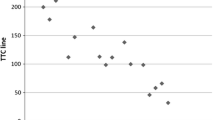Abstract
This study was carried out in order to evaluate clinical usefulness of cross-linked N-telopeptides (NTx) of type I collagen determination, in patients with primary hyperparathyroidism. Twenty-six consecutive patients (6 males and 20 females, aged 56.3±15.0, SD, yrs) with primary hyperparathyroidism were studied in basal conditions and, ten of them, after surgical cure of the disease. Cross-linked collagen peptides were measured by enzyme-linked immunosorbent assay and conventional markers of bone turnover according to standard procedures. Bone densitometry at the lumbar spine and proximal femur was performed using dual-energy X-ray absorptiometry. Bone mineral density was also assessed at the junction of the distal and middle third of the radius and at the ultradistal radius of the non-dominant arm by a dual photon densitometer. Mean urinary NTx values (194.2±121.9 pmoles bone collagen equivalents/pinoles creatinine) were significantly higher (p<0.001) in respect to those found in normal subjects. The mean increase of Z score values of both serum tartrate resistant acid phosphatase activity (1.4±1.8) and the fasting hydroxyproline/creatinine ratio (1.45±2.0) was significantly lower (p<0.02) in respect to that of NTx Z score values (3.3±3.3); the latter values were not significantly different than mean Z score values of serum osteocalcin (4.0±3.9), serum alkaline phosphatase activity (2.6±2.6) and urinary calcium/creatinine ratio (3.2±3.3). We found a significant inverse correlation between NTx values and both lumbar spine (p<0.01) and ultradistal radius bone mineral density (p<0.05); a modest inverse correlation was also observed between serum tartrate resistant acid phosphatase activity and lumbar spine bone mineral density (p<0.04). Following successful adenoma removal, the percentage decrease of both NTx and hydroxyproline was similar in patients with increased bone turnover rate; major discrepancies were observed in patients with normal values of NTx, the telopeptide reduction being greater than that of hydroxyproline. Finally, in a hypercalcemic patient with metastatic parathyroid cancer, telopeptide excretion was shown to be more sensitive in respect to urinary hydroxyproline when evaluating the effects of antiresorptive therapy. Our results seem to indicate that amongst the markers with good sensitivity, NTx is the only one that is inversely related with bone mineral density at two different skeletal sites. This assay should therefore have a place in both the initial screening and medical follow-up of patients with this glandular disorder; in fact, in both situations an increased urinary excretion of this marker should warn about the possibility of hidden bone loss.
Similar content being viewed by others
References
Heath H. III. Clinical spectrum of primary hyperparathyroidism: evolution with changes in medical practice and technology. J. Bone Miner. Res. 6(Suppl. 2): S63, 1991.
Minisola S., Rosso R., Romagnoli E., Pacitti M.T., Scarnecchia L., Carnevale V., Mazzuoli G.F. Trabecular bone mineral density in primary hyperparathyroidism: relationship to clinical presentation and biomarkers of skeletal turnover. Bone Miner. 20: 113, 1993.
Consensus Development Conference Panel. Diagnosis and management of asymptomatic primary hyperparathyroidism: consensus development conference statement. Ann. Intern. Med. 114: 593, 1991.
Hanson D.A., Weis M.A.E., Bollen A.M., Maslan S.L., Singer F.R., Eyre D.R. A specific immunoassay for monitoring human bone resorption: quantitation of type I collagen cross-linked N-telopeptides in urine. J Bone Miner. Res. 7: 1251, 1992.
Harris S.T., Gertz B.J., Eyre D.R., Genant H.K., Survill T.T., Chesnut C.H. The effect of short-term treatment with alendronate upon vertebral density and biochemical markers of bone remodeling in early postmenopausal women. J. Clin. Endocrinol. Metab. 76: 1399, 1993.
Gertz B.J., Shao P., Hanson D.A., Quan H., Harris S.T., Genant H.K., Chesnut III C.H., Eyre D.R. Monitoring bone resorption in early postmenopausal women by an immunoassay for cross-linked collagen peptides in urine. J Bone Miner. Res. 9: 135, 1994.
Minisola S., Pacitti M.T., Scarda A., Rosso R., Romagnoli E., Carnevale V., Scarnecchia L., Mazzuoli G.F. Serum ionized calcium, parathyroid hormone and related variables: effects of age and sex. Bone Miner. 23: 183, 1993.
Minisola S., Romagnoli E., Scarnecchia L., Rosso R., Pacitti M.T., Scarda A., Mazzuoli G.F. Serum carboxy-terminal propeptide of human type I procollagen in patients with primary hyperparathyroidism: studies in basal conditions and after parathyroid surgery. Eur. J. Endocrinol. 130: 587, 1994.
Romagnoli E., Minisola S., Carnevale V., Scarda A., Rosso R., Scarnecchia L., Pacitti M.T., Mazzuoli G.F. Effect of estrogen deficiency on IGF-I plasma levels: relationship with bone mineral density in perimenopausal women. Calcif. Tissue Int. 53: 1, 1993.
Rowe J.W., Andres R., Tobin J.D., Norris A.H., Shock N.W. Age-adjusted standards for creatinine clearance. Ann. Intern. Med. 84: 567, 1976.
Papapoulos S.E., Frolich M., Mudde A.H., Harinck H.I.J., Berg H.V.D., Bijvoet O.L.M. Basal concentrations and response to bisphosphonate treatment. J. Clin. Endocrinol. Metab. 65: 89, 1987.
Thiebaud D., Jaeger P., Gobelet C., Jaquet A.F. A single infusion of the bisphosphonate AHPrBP (APD) as treatment of Paget’s disease of bone. Am. J. Med. 85: 207, 1990.
Minisola S., Carnevale V., Pacitti M.T., Romagnoli E., Scarnecchia L., Rosso R., Minisola G., Mazzuoli G.F. Serum osteocalcin in metabolic bone disease: what is its real significance? J. Endocrinol. Invest. 16: 277, 1993.
Author information
Authors and Affiliations
Rights and permissions
About this article
Cite this article
Minisola, S., Pacitti, M.T., Rosso, R. et al. The measurement of urinary amino-terminal telopeptides of type I collagen to monitor bone resorption in patients with primary hyperparathyroidism. J Endocrinol Invest 20, 559–565 (1997). https://doi.org/10.1007/BF03348019
Accepted:
Published:
Issue Date:
DOI: https://doi.org/10.1007/BF03348019




